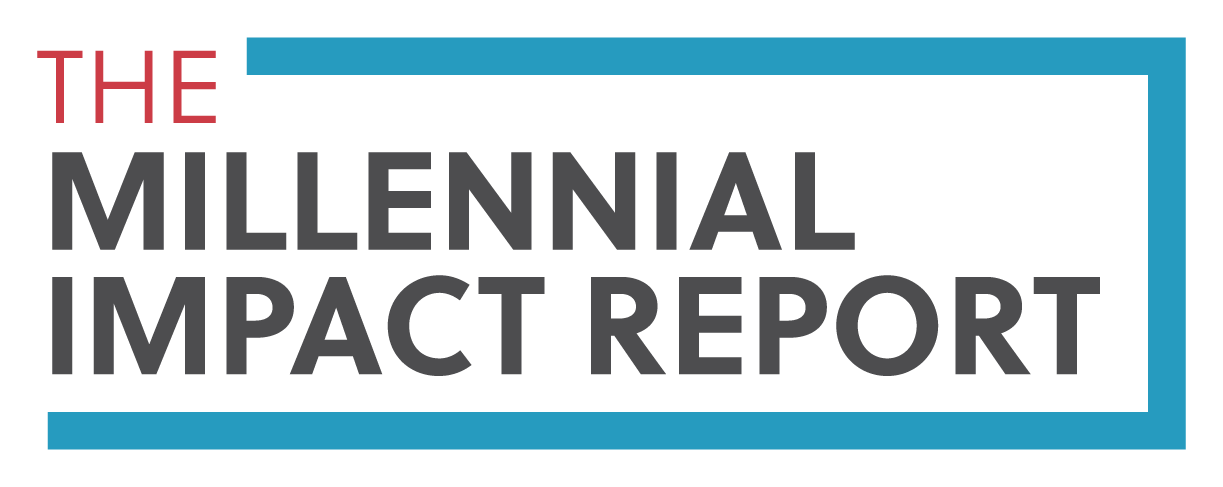– Case Foundation
– Ryan Scott, Forbes
The Millennial Impact Project is the largest body of data and analysis on how US millennials interact with causes. Since beginning the study in 2009, Achieve has researched the behavior and preferences of more than 150,000 millennials (born 1980-2000) through surveys, focus groups and one-on-one interviews.
Our goal: To accurately capture and comprehend this fearless generation’s cause engagement.
The series of Millennial Impact Reports has shown consistently how and why millennials are motivated to engage with philanthropic causes they care about. As the largest generation in the country and now with every member over the age of 18, millennials are shaping the way people of all ages give, volunteer, share their passion about and otherwise engage with causes.
History of The Millennial Impact Project
Even before the generation born 1980-2000 was labeled, millennials seemed on the surface to be exhibiting far different behaviors than their forebears – behaviors that could negatively affect nonprofits and causes. However, most of the pronouncements about the generation were coming from outside it.
Achieve and the Case Foundation decided the members of this generation needed a voice. We seek to give them one.
In 2009, we began an effort to understand the dynamics of the relationship between causes and this new cohort of potential donors and activists. We established The Millennial Impact Project to fill a knowledge gap that existed in the field: How does the millennial generation support, connect with and get involved in causes? And how can causes reach this new audience?
In the almost 10 years since we began, our research has illuminated a much more caring generation than generally believed, one that is complex in their depth of passion toward causes and, at the same time, straightforward in their desire for authentic interactions with them.
We use a mixed methods (qualitative and quantitative) data-gathering approach in our studies – including surveys and interviews, as well as ethnographic inquiry that incorporates participant observation as a part of field research. (Learn more about our research methods and philosophy.)
A New Donor Base: 2009-2013
We first examined the generation as donors, releasing the Millennial Donors Study in 2010 and the Millennial Donors Report in 2011; together, these data offered the industry insights into what motivates a millennial donor’s interest and action. For the 2012 Millennial Impact Report, we examined how young professionals are driven by larger movements and inspired to donate or volunteer. The 2013 Millennial Impact Report explored how organizations can motivate these individuals to volunteer and give.
As our research evolved, we made a strategic decision to begin studying millennials through focused lenses to provide even keener insights.
More Focus, Keener Insights: 2014-2016
The 2014 Millennial Impact Report examined corporate responsibility and what millennial employees (and potential hires) look for in company cause work. Following up on that work, our 2015 Millennial Impact Report specifically examined the relationship and potential influence between employees and their managers.
2016 presented only the second opportunity to study millennial cause engagement during a presidential election year. Our researchers tracked millennials during and after the campaign season, publishing reports in waves to share what we were learning in near-real time. After the election, we were one of the first research outlets to provide data on why millennials voted the way they did. The research also showed why cause engagement behaviors changed and how they were influenced by gender, age, geographic location and race/ethnicity.
Creating a Dialogue: 2017
During that study, we found millennial behaviors to be far more muted and passive than we anticipated. We also found that millennials were quietly redefining terms long accepted in the cause and philanthropy space: Activist. Cause. Social issue. Ideology.
Inspired by their comments, our aim in 2017 was to create a genuine, active dialogue among millennials and organizations about mutually beneficial cause involvement and approaches to solving societal challenges. Download the 2017 research.
Achieve’s data and analysis are a reliable assessment of what are now most causes’ largest source of donors and supporters. Our report data has been downloaded more than 45,000 times, and we have recorded nearly 5,500 references in international media outlets, social media, blogs, forums and elsewhere online.
10 Years, Looking Back
In 2019, we set out to synthesize the decade of research that we have conducted on the millennial generation and pull out top insights from ten years of research – which has surveyed more than 150,000 millennials and created the largest body of data and analysis on how U.S. millennials interact with causes.
Our capstone report, The Millennial Impact: 10 Years Looking Back demonstrates why and how the nation’s youngest generation of adults has engaged in doing good, how they have changed philanthropy, what they expect of the public, private, nonprofit and government sectors in addressing societal challenges and the consequences for ignoring their powerful influence.
The mountain of data and analysis created by this decade of study has led to a general framework for understanding millennial (1980-2000) constituents.
We hope causes, and the nonprofits and companies that support them, use the information presented here to inform decisions related to growth, recruitment, fundraising and sustainability for many years to come.
Millennial Impact Project research brought to you by:

As a digital agency for causes, Achieve leverages its expertise in storytelling, digital marketing, social media and web technology to inspire audiences - whether current of yet to be discovered - to take action. Achieve leads and conducts all research and analysis for The Millennial Impact Project and other studies related to giving and donor behavior. achievecauses.com.
Want to learn more? See what Achieve’s researchers learned in the Millennial Alumni Report and #GivingTuesday Donor Report.
Millennial Impact Project research supported by:

Established by digital pioneers Jean and Steve Case, the Case Foundation invests in people and ideas that can change the world. In 2008, the Case Foundation embarked on a program to spark engagement between millennials and the causes they care about, with the release of Social Citizens. The following year, 2009, the Foundation’s support for The Millennial Impact Project was a natural next step to better understand this fearless generation of changemakers. Since 2009, the partnership between the Foundation and Achieve has led to the development of industry leading research, dialogue and convenings, as part of a shared cross-sector approach to better engagement with the Millennial generation. casefoundation.org

